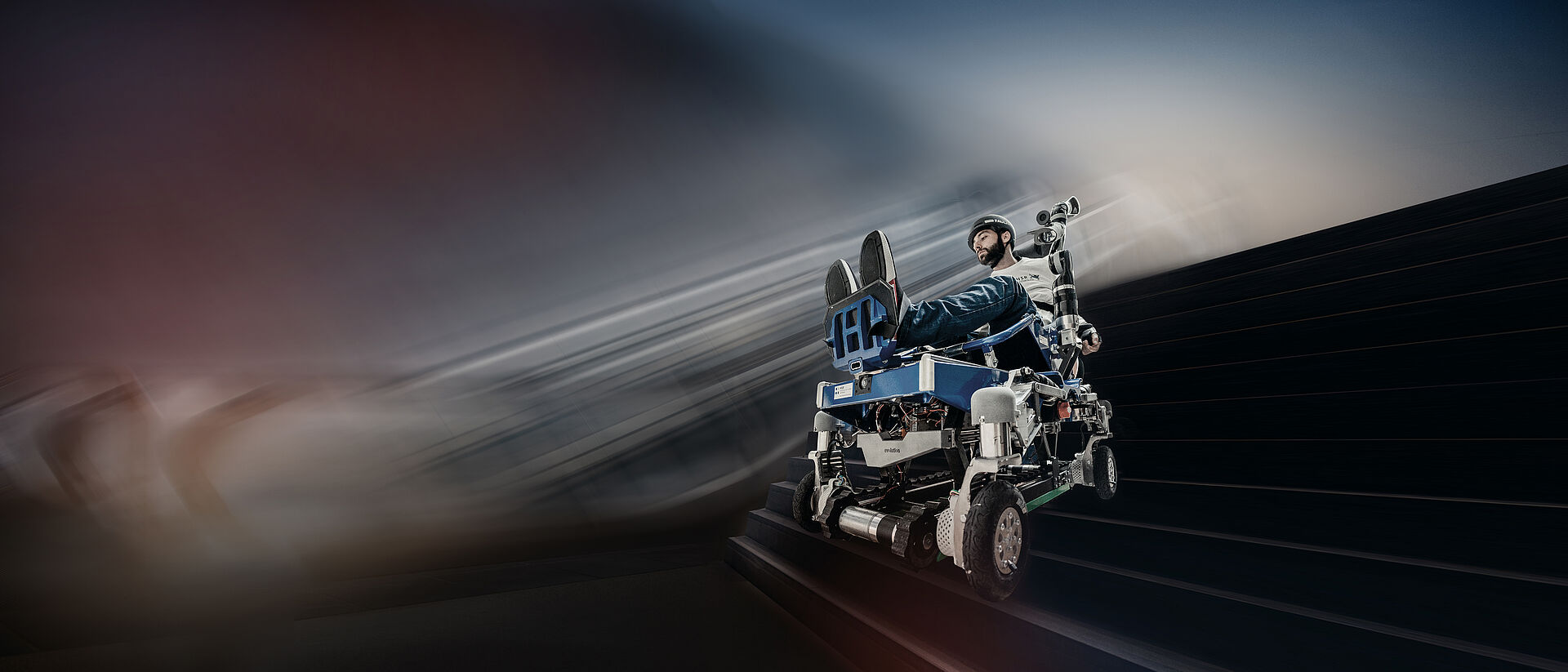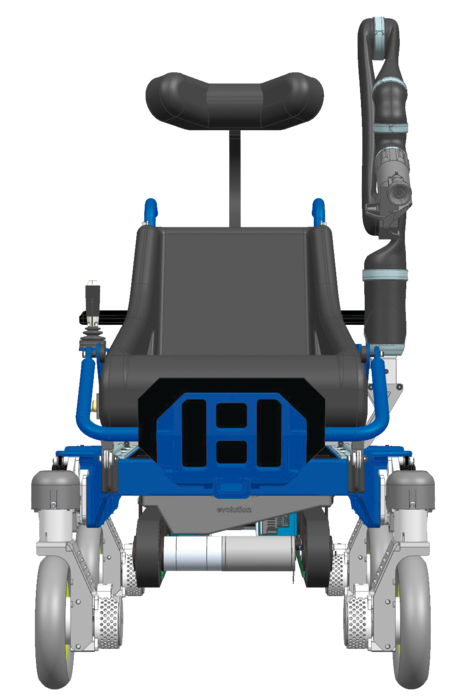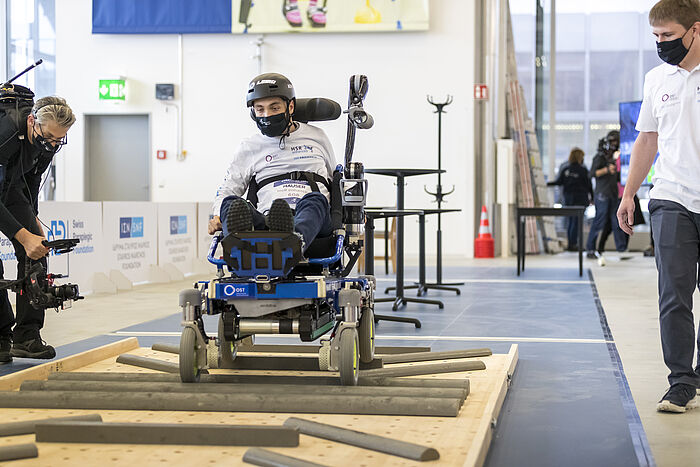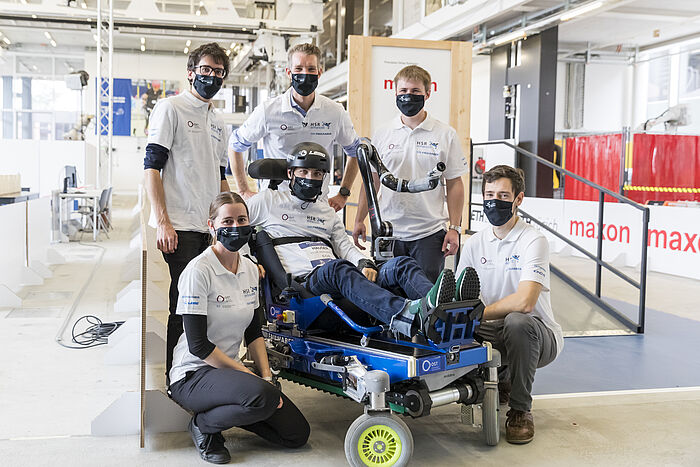The long part to high-tech sports equipment
War, accident, illness or old age – disabilities can affect anyone. Since time immemorial, people have been searching for technical solutions to help make life easier for those affected. The pioneers were the Chinese, who are said to have used a sort of chair with wheels already in 1300 BC. In the Middle Ages, attempts were made that ranged from simple, pushcart-like vehicles to imaginative – though cumbersome – drive solutions with tackles around the year 1420.
One of the oldest pictorial documents is from 1595. It shows King Philip of Spain in a vehicle similar to a wheelchair which, in spite of his serious gout condition, allowed him to carry out his governmental affairs. The first self-propelled construction was developed in 1655 by Nuremberg watchmaker Stefan Farfler, who himself suffered from polio. The timeline below shows other milestones on the way to the motorised racing wheelchair.
The Cybathlon race track: A true herculean task
Like the Olympic Games, the Cybathlon competition is held every four years. The athletes participate in six different disciplines. Races are also held in between competitions, usually within the scope of trade fairs.
In the "Wheelchair Race" category, pilots with a severe walking disability complete a defined obstacle course in a motorised wheelchair. The individual stations involve considerable technical challenges. Having already won two first place trophies, this is the main discipline for the HSR Enhanced team of the University of Applied Sciences Rapperswil. Many teams opt for caterpillars for stair climbing. HSR Enhanced, however, uses a hybrid drive concept consisting of caterpillars for the stairs and individually steered wheels for all other obstacles, which make the wheelchair extremely manoeuvrable.
To overcome the stairs, the wheelchair has a lowerable supplementary module called 'Herkules' installed under the chassis. This module converts the wheelchair from a wheeled vehicle to a caterpillar vehicle. To ensure that the driver sits securely when the wheelchair is in an inclined position, the seat and therefore also the centre of gravity is shifted. This shift also affects traction and handling. It is also a useful feature for the wheelchair user in everyday situations: When the seat is at the forward position, the user's feet are lowered so that he can comfortably approach a table. In the rear position – the standard position for moving over level terrain – the legs of the driver are raised and stretched out, which makes the combination of driver and wheelchair shorter and more compact. Motors from FAULHABER are used in the stair module, for seat adjustment and for steering the individual wheels. 'Herkules' is lowered using two powerful, brushed motors that lift the total weight of around 180 kg from the wheels onto the caterpillars. The same motor type, here with gearhead and lead screw, is also used to move the seat. The wheels are steered by four BXT brushless motors with passive gearhead. Thanks to their innovative winding technology and optimised design, they are able to achieve an extremely high torque. Their performance and efficiency significantly exceed other motors of similar size. With a speed of up to 10,000 rpm, they can perform the steering movement practically instantaneously. Their digital Hall sensors, integrated as standard, can be used for extremely precise speed control.
Anyone who wants to push limits must go to the limit
In a challenging technological competition like the Cybathlon, all participants grow with their tasks. This applies for the Swiss developers at the University of Rapperswil just as it does for the German engineers at FAULHABER in Schönaich. There, the valuable synergy effects from the experiences and solutions acquired at the limit of what is technically possible are directly used for the optimisation and development of new products in the application areas of human augmentation and prosthetics. Benefiting from this technology transfer are first of all the application engineers and later people with disabilities around the world. Whether myoelectric hand prostheses, arm and leg prosthetics or even exoskeletons and workbots. The list of application areas for which FAULHABER has suitable drive solutions available standard or develops custom solutions is long. Due to this expertise, Team HSR Enhanced opted for drive systems from FAULHABER.
Interview with Professor Dr. Christian Bermes from the Department for Laboratory Automation and Mechatronics at the University of Applied Sciences Rapperswil (HSR).
FAULHABER: Do you recall the first time your university took part in the Cybathlon?
Prof. Dr. Bermes: When the first Cybathlon was organized in Zurich in 2016, we learned of it quite late on. Our goal was to be accepted as a participant – to do this we had just ten months to develop a competition-ready wheelchair from scratch. But the task was appealing and the technical challenge was extremely interesting. Our team was highly motivated and we were able to win the "Powered Wheelchair Race" category, thereby fulfilling an extremely ambitious dream.
FAULHABER: At last year’s Cybathlon Wheelchair Series in Kawasaki (Japan), your team again won the gold medal. How do you see your chances this year?
Prof. Dr. Bermes: We will probably be among the favourites, but just like in motorsport, the rules and regulations change to reflect technical progress, and the bar is being raised continuously. For example, while only three steps needed to be mastered at the first competition in Zurich, the number had increased to six in Kawasaki. The door on the obstacle course was no longer allowed to be opened by the driver himself, but instead a robot arm had to open the door and then close it again after the pilot had passed through. I expect another exciting competition.
FAULHABER: Aside from the sporting success, how do you benefit from the Cybathlon competition?
Prof. Dr. Bermes: Our Rapperswil Department for Laboratory Automation and Mechatronics focuses on applied research. The competition is, so to speak, an acid test for our newly developed technologies. Around one hundred teams from all over the world participate. A great deal of professional exchange takes place there – all with the objective of making people more independent through technology that is suitable for everyday use. The complex interaction between pilots and machines can also be transferred to other areas, however, such as automation and robotics in industrial production: here, too, man and machine solve complex tasks together.
FAULHABER: What challenges does the competition place on the electric drive systems of the HSR enhanced wheelchair?
Prof. Dr. Bermes: The motors must fulfil some pretty extreme demands. We can't use any bulky parts in or on the wheelchair; we therefore always try to keep the dimensions of the modules to a minimum. The same, of course, also applies to the weight – every gramme saved makes the vehicle more manoeuvrable and improves handling. Furthermore, we don't want to waste battery power, which is why we want to use drives that have the highest possible degree of efficiency. The motors from FAULHABER simply provide the best technology.
FAULHABER: You describe yourself as being passionate about sport. What role does sporting spirit play with the driver and in the team?
Prof. Dr. Bermes: Our pilot, Florian Hauser who has been paraplegic since a motorbike accident, is an ambitious sportsman who always gives his all. The same spirit can be found in the team made up of bachelor's and master's degree students and engineers. Everyone shares the excitement of the race because once the start signal is given, our intervention is no longer allowed. It's just like in Formula 1: We try to fully exhaust the technical possibilities. If we have done our work well, we provide the ideal conditions for success. During the race, however, it is the pilot alone who is responsible for getting the best performance when out on the track – to stay with the motor racing analogy. In Florian, we have the perfect pilot for the task.




